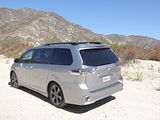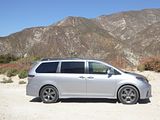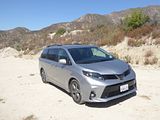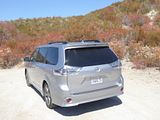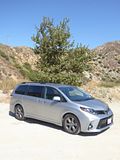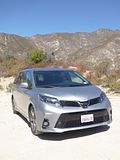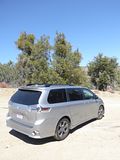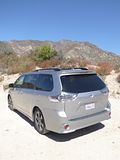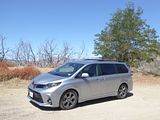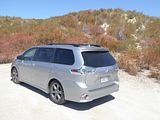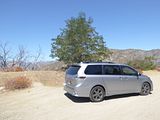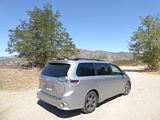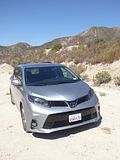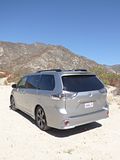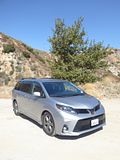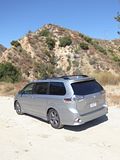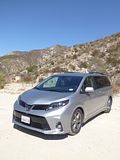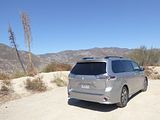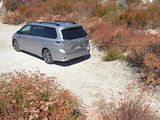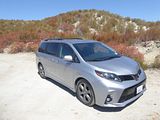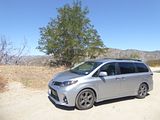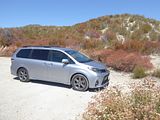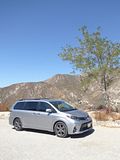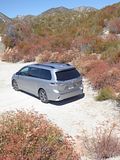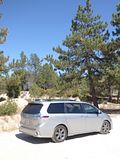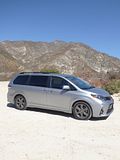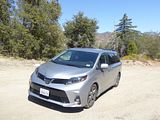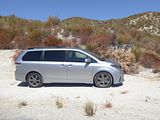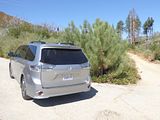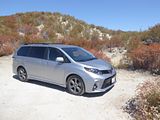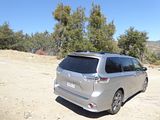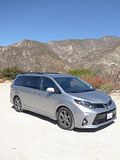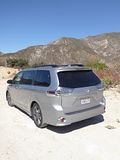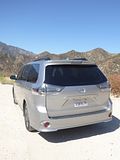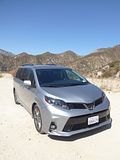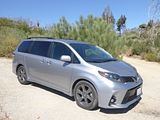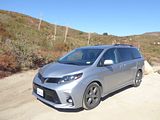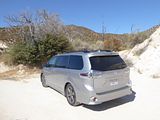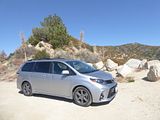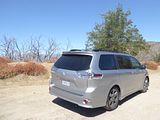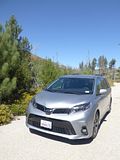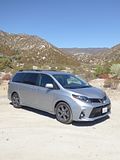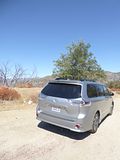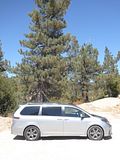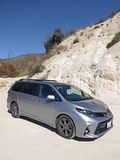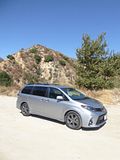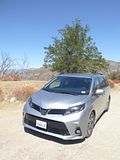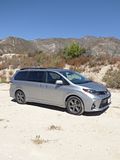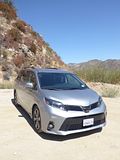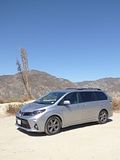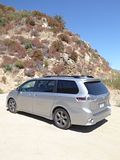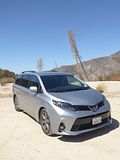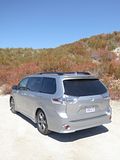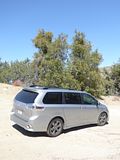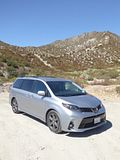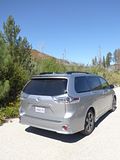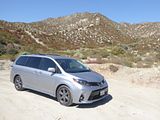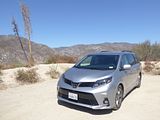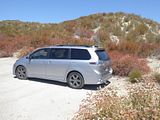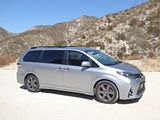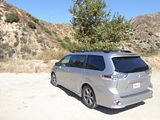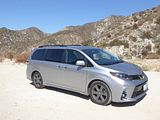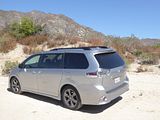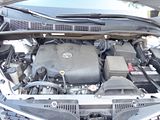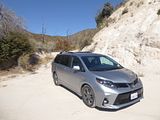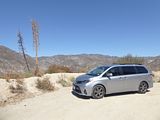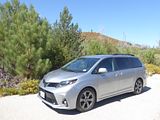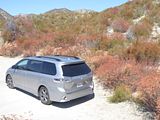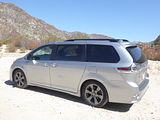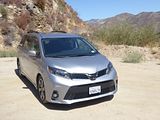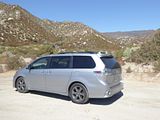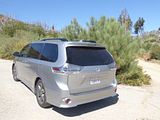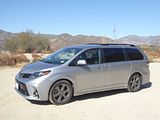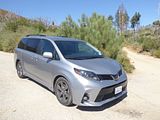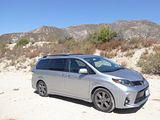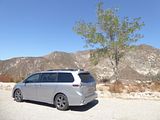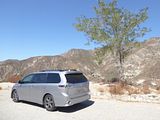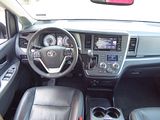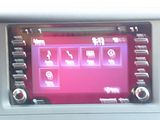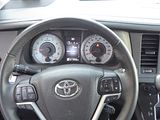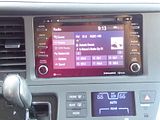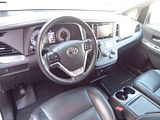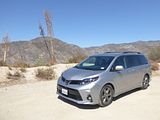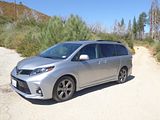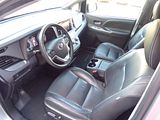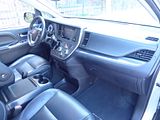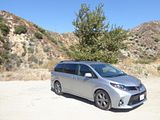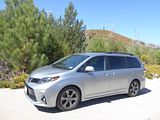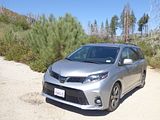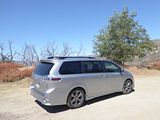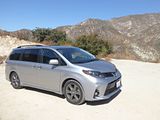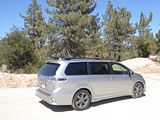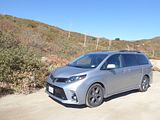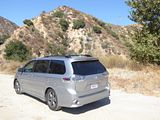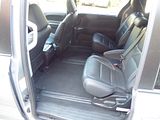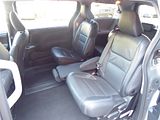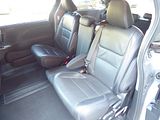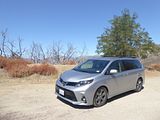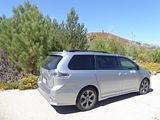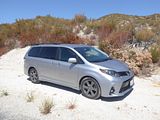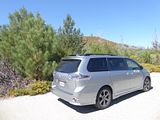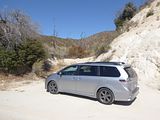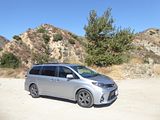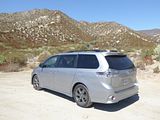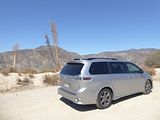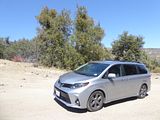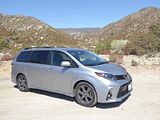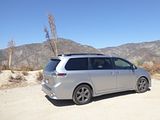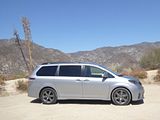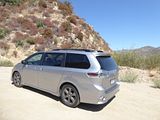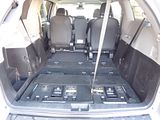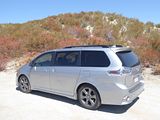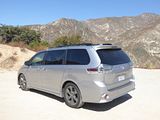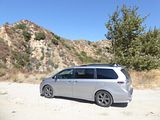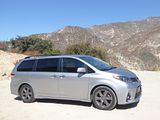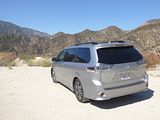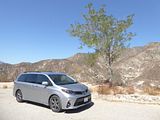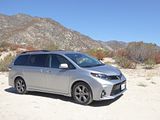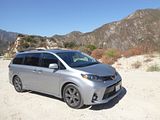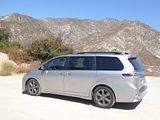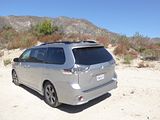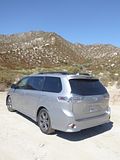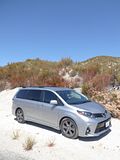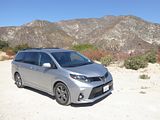Walking into the vast Hertz LAX facility early on the last Saturday morning of my September 2019 trip, I was dismayed to see that there were not that many cars parked up. Nothing like as sparse as it had been in Phoenix earlier in the week, where there were so few cars you could count them all, but definitely a lot emptier than usual. Having wandered round, looking for something that I had not sampled before, about the only thing of interest was a brand new VW Atlas. I decided to take it, and got as far as the gate, only to be told by a rather apologetic staff member that there was a “Stop Rent” on it, so I would have to return it. Disappointed, I got out, and wandered around, noting that buses were bringing renters at far greater a rate than cars were appearing freshly serviced, so the choice was getting worse. Nothing really caught my eye at all, and in the end, about the only vehicle available that was on my list of things to sample was the Toyota Sienna presented here. I have driven this generation Sienna before, exactly two years ago, when I sampled a 2016 XLE model, with a high mileage on it. Since that time, Toyota have applied a mid-cycle update to it, freshening the looks, increasing the power, adding more safety features and making a few changes to the standard specs. The one I found was first plated in January 2018 and had done 37,000 miles and had a few scars on the body (none of which are too obvious in the photos apart from the front end!) and was in SE spec, which I thought would make it all different enough from that XLE of a couple of years previously. Perhaps more importantly, this test was only a few days after sampling Chrysler’s Pacifica, one of the arch rivals in the MiniVan sector (the only others are the Honda Odyssey, Kia’s Sedona and the soon to be discontinued Dodge Caravan). US press opinion is that the Pacifica is the better vehicle – just – and I wondered if I would agree with them.
There is a steady market for vehicles of this type in the US, but it is nothing like it was in its heyday, before the Crossover took over, which is why there are only four manufacturers offering product of this type. All of them tend to have longer production cycles than other vehicle types. With the Dodge Caravan about to cease production, the Sienna is the oldest design by some margin. It was first shown at the 2009 Los Angeles Show, and went on sale in February 2010 as a 2011 model year vehicle. Apart from a mild facelift for the 2017 model year, not a lot has changed in the interim apart from some spec changes and the addition of some new features in an effort to stay competitive with the more recent triumvirate of Pacifica, Odyssey and Sedona. Total sales have reduced from a high of 137,497 in 2015, but this is as much a reflection of how the market continues to favour Crossover type vehicles above all else as anything suggesting that the Sienna is no longer competitive.
SE trim is the sporty one in the range offered. You might think the words “sporty” and MiniVan are something of an oxymoron, and if you add in Toyota Sienna that they certainly are, but it is all relative. Certainly Toyota have tried with the appearance. SE trim brings a revised front end, with a gloss black “grille” and insert lower down at the front, extended bumpers front and rear, side skirts and clear-lensed rear lights, as well as larger 19″ alloys with a dark grey finish and black roof rails. It will appeal to some, I am sure, but not to me.
Mechanically the SE is the same as the other Sienna versions, with a 3.5 litre V6 unit and an 8 speed gearbox. All models have a little more power and torque than the last one I drove, now outputting 296 bhp, thanks to a new direct-injection unit, and from 2017 the gearbox gained an extra couple ratios, now up from 6 to 8. which means that this is the most powerful vehicle in the class. Potent it may be, but fast it is not. If you apply normal type pressure on the throttle you will conclude that the Sienna is plain slow. It is smooth, and refined, for sure, but acceleration seems marginal, so you have to be more brutal than that to get any sort of go out of it. And if you work it hard, then it will respond, and there is indeed actually plenty of oomph, at least for the 1-up mode in which I drove it. An Eco mode light shows on the dash when it thinks you are being thrifty or the engine is no working that hard, and it was on some of the time during my test. I covered 147 miles, and the Sienna needed 6,25 gallons to refill as a result, which computes to 23.52 mpg US or 28.1 mpg Imperial, a better result than I achieved with the last Sienna. I did cover a part of the test distance at freeway cruising speed and here the noise levels were very low indeed, with only the noise of the fan challenging the sound system.
Perhaps slightly unfairly, I took this Sienna on roads where a truly sporty vehicle would be fun, the Angeles Forest Highway, Angeles Crest Highway and the Big Tujunga Canyon, in the hills up above Los Angeles, roads used by many manufacturers for honing their cars. Now to expect something like a MiniVan to be genuinely fun on roads like these is probably somewhat optimistic, but I had already discovered that the firmer suspension and larger wheel did make a difference on the roads in the valley. On some surfaces the change is welcome, with the Sienna proving less wallowy and inclined to float, but there were others, slightly rougher surfaces, such as the concrete ridges on the freeway, where it was clear that it was too firm and you could feel and indeed hear every joint. The ride quality really does seem to vary depending on the surface, and in the mountains where they are generally better than down the valleys, it was fine. More to my surprise, the steering proved no worse than you find in many other vehicles these days. It is light, but there is some feel, and in fact you could hustle the Sienna along the swooping bends with more aplomb than you might imagine. It leans on the corners, and there is plenty of understeer so you are not going to tackle those bends at the speeds that I would in say a Focus Hatch, but this was not as challenging an experience as it might have been. I had already learned from the last Sienna that Toyota had fixed the braking issue that so alarmed on the previous generation model, and they now feel like they will stop you and quite quickly, and there is decent sensation in the pedal. There is a foot-operated parking brake pedal. Although this is a large vehicle in every dimension, it is surprisingly manoeuverable. It is easy to turn round, and not hard to place on the road. A second piece of glass in the door mirrors helped to alleviate blind spots, and the rear-view camera gave a clear view of just how close you were to any obstacle – useful when the back of the car is such a long way away. Included in the 2017 facelift were a number of safety features, in an active safety bundle called Toyota Safety Sense P which includes forward collision warning, pedestrian detection, automatic emergency braking, lane departure warning, lane keep assist, automatic high beams, and adaptive cruise control.
The interior of this Sienna was little different from the one I sampled a couple of years ago. That one had pale grey leather, whereas this test car was black, which was probably more practical for a family-oriented vehicle. And the inlay on the dash was a particularly nasty sort of grained plastic that was supposed to look like, well, I don’t know that it was really supposed to be carbon fibre or some just light coloured wood. but it was horrid whatever it was supposed to be. There is some leather used, on the dash top and part of the door casings, but there are also a lot of hard plastics and the odd grained plastic that Toyota sometimes uses on the dash of other models covered a lot of the doors. The dash layout is at least clear and easy to use. A single cluster contains the two instrument dials, which in this SE version have a white background, but retain the odd crenellated markings around the perimeter which I remarked on in the XLE test. Small water temperature and fuel gauges are inset in the bottom of these and they do actually have a pale blue graduation scale, though this was only evident in certain lights. There is a trip computer display area, and you cycle through the options for this using buttons on the right hand steering wheel spoke. The wheel spokes also contain the audio unit repeaters. Cruise control operates from a stubby right hand stalk, set below the larger indicator one. Lights, with an auto feature, are combined with the indicators on he left hand stalk. The middle of the dash contains the 7″ display screen for the Entune infotainment system. This was much as before with AM, FM and (non-working) XM Satellite radio being the audio features operated from here and you also get an app suite which like all but the very latest Toyota models does not include Android Auto or Apple Car Play, five USB ports, Bluetooth, a six-speaker stereo, and voice recognition. There are a number of buttons on either side of the unit to operate it. Beneath this is the gearlever, and a whole array of buttons for the tri-zone automated climate control, which operates for the rear compartment as well as the front. Beneath this are a pair of pop-out cupholders. Evidence of the age of the design of the Sienna comes form the fact that not only do you need to put a physical key in the slot to start it, but the key is just that with a separate fob with the remote locking buttons on it. Back in 2010 when the design was new, this was quite common, but it feels very old fashioned now.
Electric adjustment of both driver and front passenger seat is standard. Initially I thought that I would have liked the seat to go still lower, but I quickly got used to the relatively high seating position. There is certainly plenty of headroom. The wheel telescopes in/out and up/down, and there are height adjustable seat belts. As with the XLE version, the seats did not really meet with my approval, seeming to be rather too shapeless, so you slid around on them quite a bit, even when strapped in by your seatbelt. I did not spend a vast amount of uninterrupted time to be able to vouch for their long term comfort, but the omens were not good. You do get a drop down armrest attached to the side of the seat and there are seat heaters as standard.
Access to the rear seats is through the side sliding doors. These are electrically assisted, though they are quite slow to operate. To close them you press the button in the B pillar, the move out of the way. Second row occupants should have no cause for concern when it comes to roominess. There are two separate Captain’s Chair style seats, each with armrests on either side of the seat. They are on sliders, with a long travel from rear-most to furthest forward position. Unless you set them as far forward as they would go and the front seats as far back as they would go, then legroom will not be an issue, and nor is headroom thanks to the tall body of the Sienna. There is provision for a third occupant in the middle row. In the previously tested XLE version, this was a separate seat, stored in a well to the side of the boot when not in use, but here it was simply attached to the side of the driver’s side seat, but folded down. It is very narrow, so only suitable for children. There are separate controls for the climate control, with these mounted on a panel on the roof on the driver’s side. There are side window blinds which clip up over the window to keep the sun out, and as well as bins on the doors there are map pockets in the back of the front seats for odds and ends. The rear face of the centre console has a pullout section which contains two cupholders and there are USB and charging sockets here as well as handy hooks to hang things from.
Unlike many three-row vehicles, adults really could travel in the back row here. There is ample space for two, and three people if they are small, and with the seat set up high enough, your knees would not be in your ribs when seated here. Getting in is reasonable easy, as you pull on the strap on the side of the second row seat, which bring the cushion and backrest together somewhat, then the whole thing just slides forward, leaving quite a decent sized space to clamber through. Occupants here get the side window blinds, air vents in the roof, a deep stowage cubby on either side and cupholders.
The tailgate is also electrically assisted. I thought that when fully open it was not really high enough, and you would need to be careful not to bang your head on it. Even with all the seats erect, there is a reasonable amount of luggage space. It is deep rather than long, though, extending down well below the base of the tailgate. More space is created by folding down rear seats. The rearmost row are easy to deal with. There is a release lever in the middle of the seat backing, which then allows you to pull the whole seat towards the rear of the car and the to drop it down into the well. The headrests tuck nicely down in front of the backrest, and the resulting floor is now flat, flush with the base of the tailgate. The only issue is the middle seat belt which is anchored from the roof and so gets in the way somewhat. With these seats folded, there is a vast luggage area, but if that is not enough, then you can remove the second row. And I do mean remove. That is easy enough, as there is a release lever under the cushion, which allow you then simply to pull the seat out. Getting it back in on the mounting channels proved a little more awkward. The seats are quite heavy, and clearly you would need to stow them somewhere. They do not actually fold down, unlike those of say the Pacifica. Inside the cabin there are plenty of places for odds and ends. There is a split level glovebox, the lower part a bin, the upper bit a shelf. Long but quite narrow door bins feature. Between the front seats there is a lipped recess on top of what turns out to be a very deep storage bin, and there is a lipped tray lower down on the floor in front of this unit. A small lidded area is over the driver’s left knee.
The 2018 Toyota Sienna was available in five trims: L, LE, SE, XLE and Limited. All have the same engine and gearbox. Uniquely in its class, the Sienna is available with All-Wheel Drive. Not with every trim though, as this was only offered with the LE, XLE, and Limited trims and note that AWD models seat seven. If you want eight seats, you’ll have to stick with an LE, SE, or XLE model, which only come with FWD. The standard Sienna L is only a front-wheel-drive seven-seater. It also comes standard with cloth upholstery, second-row captain’s chairs, three-zone automatic climate control, a rearview camera, five USB ports, Bluetooth, the Entune infotainment system, a 7-inch touch screen, phone-linked navigation, a six-speaker stereo, voice recognition, forward collision warning, pedestrian detection, automatic emergency braking, lane departure warning, lane keep assist, automatic high beams, and adaptive cruise control. The Sienna LE adds an eight-way power-adjustable driver’s seat, power-sliding side doors, second- and third-row sunshades, a 120-volt power outlet, HD Radio, satellite radio, and a built-in Wi-Fi hot spot. The Toyota Sienna SE comes with genuine leather upholstery, heated front seats, a four-way power-adjustable front passenger seat, a leather-wrapped steering wheel, a power liftgate, and sport-tuned steering and suspension, 19″ alloys and various styling changes. SE Premium models add blind spot monitoring, rear cross traffic alert, integrated navigation, a moonroof, Driver Easy Speak, a rear-seat DVD entertainment system, two additional 120-volt outlets, proximity keyless entry, and push-button start. The standard Sienna XLE adds proximity keyless entry and push-button start. Features in the XLE Premium trim include rear parking sensors, Driver Easy Speak, a rear-seat DVD entertainment system, two additional 120-volt outlets, and integrated navigation. Tope of the range Toyota Sienna Limited includes a dual-pane moonroof, a heated steering wheel, integrated navigation, a 10-speaker JBL premium stereo, and front and rear parking sensors. Limited Premium models come with a surround-view parking camera, rain-sensing windshield wipers, a rear-seat DVD entertainment system, and two additional 120-volt outlets.
A couple of years ago I learned that whilst the third generation Sienna might not look that different from its predecessor, it was a much better vehicle, and whilst it was never going to be fun to drive its blend of space and convenience features meant that it had much to commend it, and the weaknesses were more inherent in this class of car rather than being particular Toyota failings. The same conclusions apply now, a couple of years on. I’ve not sampled the Odyssey (reckoned to be the class leader) or the Sedona yet, but have recently driven the Pacifica and I would say it is a very close call between the two as to which is best. The Sienna certainly felt more spacious, but this is more a perception than a reality, as both are very commodious indeed, whereas the Chrysler was that bit better to drive. It might come down to personal choice and the deal you could do. And for the rental car customer, who is likely to see large numbers of both, well, I think I would take the Pacifica, but if forced into a Sienna, I would not grumble. And if it were an SE rather than an XLE, apart from that horrid plastic wood, you don’t have to look at the rather unfortunate styling “enhancements”, but you probably will appreciate the slightly sharper dynamics, so I would take the SE version if I could find one.



